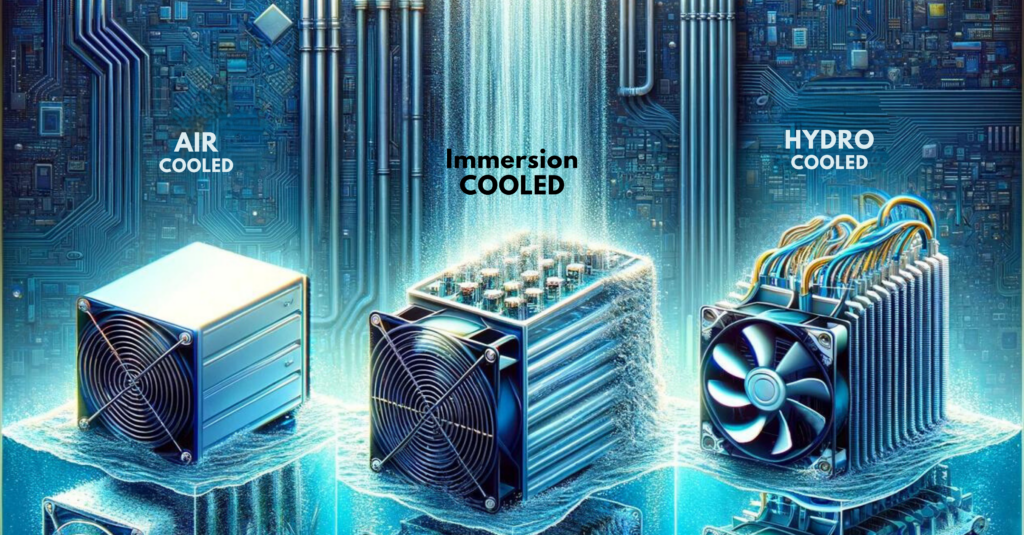Air-cooled vs. Immersion vs. Hydro ASIC Machines: Understanding ASIC Machine Differences

03/21/24
Introduction:
The efficiency and longevity of ASIC machines are paramount when it comes to ASIC Mining. A significant factor in achieving these goals is the cooling technology used. Traditional air-cooled systems, innovative immersion cooling solutions, and emerging hydro (water) cooling techniques each offer unique benefits and challenges. This article delves into the intricacies of air-cooled, immersion, and hydro cooling systems for ASIC machines, comparing their efficiency, cost implications, and suitability for different mining operations. By understanding these differences, miners can make informed decisions on optimizing their setups for maximum profitability and sustainability.
Outline:
- Overview of ASIC Machine Cooling Needs
- Importance of cooling in ASIC mining operations.
- Challenges posed by heat generation in ASIC machines.
- Air-Cooled ASIC Machines
- How air cooling works in ASIC machines.
- Advantages: simplicity, cost-effectiveness, and ease of setup.
- Disadvantages: noise, dust, and limitations in heat management.
- Immersion Cooling ASIC Machines
- Introduction to immersion cooling technology.
- Advantages: superior cooling efficiency, noise reduction, and potential for overclocking.
- Disadvantages: higher initial setup costs and maintenance requirements.
- Hydro Cooling ASIC Machines
- Explanation of hydro (water) cooling systems for ASICs.
- Advantages: efficient heat dissipation, quieter operation compared to air cooling.
- Disadvantages: complexity of setup, potential for leaks, and maintenance.
- Comparative Analysis: Efficiency and Cost
- Comparison of cooling efficiency across the three systems.
- Cost analysis: initial investment, operational costs, and long-term savings.
- Choosing the Right Cooling System for Your Mining Operation
- Factors to consider: scale of operation, environmental conditions, and budget.
- Case studies: real-world applications of each cooling system in mining setups.
- Future Trends in ASIC Machine Cooling
- Innovations on the horizon for ASIC cooling technologies.
- Potential impact of emerging cooling solutions on the mining industry.
Overview of ASIC Machine Cooling Needs
ASIC machines, designed for cryptocurrency mining, perform complex calculations at high speeds, generating significant amounts of heat. Effective cooling is crucial to maintain operational efficiency, prevent hardware damage, and extend the lifespan of these machines. Heat management challenges include maintaining optimal temperatures, reducing the risk of overheating, and ensuring that the mining operation runs smoothly and profitably.
Air-Cooled ASIC Machines
Air cooling is the most common method used in ASIC mining operations. It involves using fans to circulate air around the ASIC chips, dissipating heat into the surrounding environment.
- How Air Cooling Works: Air is drawn into the machine and passed over the components, absorbing heat before being expelled. This process keeps the ASIC chips at a safe operating temperature.
- Advantages: Air-cooled systems are relatively simple and inexpensive to set up and maintain. They are well-suited for small to medium-sized mining operations where noise and space are not critical issues.
- Disadvantages: The main drawbacks include noise from the fans, the accumulation of dust which can reduce efficiency over time, and limitations in cooling capacity, which can be problematic in warmer climates or densely packed mining setups.
Immersion Cooling ASIC Machines
Immersion cooling involves submerging ASIC machines in a non-conductive liquid that absorbs and dissipates heat more efficiently than air.
- Introduction to Immersion Cooling: This technology uses a thermally conductive but electrically insulating liquid. ASIC machines are immersed in this fluid, which circulates, drawing heat away from the components.
- Advantages: Immersion cooling significantly enhances cooling efficiency, allowing for higher operational intensities and potentially overclocking ASICs for better performance. It also reduces noise and is less affected by external temperatures.
- Disadvantages: The higher initial setup costs and ongoing maintenance of the liquid cooling solution can be prohibitive for some miners. There’s also a learning curve in managing and maintaining an immersion cooling system.
Hydro Cooling ASIC Machines
Hydro cooling, or water cooling, involves using water to transfer heat away from ASIC machines, typically through a closed-loop system of pipes and radiators.
- Explanation of Hydro Cooling: Water is circulated through a system that includes water blocks attached to heat-generating components. The heated water then moves to a radiator where it is cooled and recirculated.
- Advantages: Hydro cooling offers efficient heat dissipation and operates quieter than air-cooled systems, making it suitable for larger mining operations concerned with noise and thermal management.
- Disadvantages: The complexity of installing a hydro cooling system, the risk of leaks, and the need for regular maintenance to prevent issues like algae growth or corrosion can deter some miners.
Comparative Analysis: Efficiency and Cost
When comparing air-cooled, immersion, and hydro cooling systems, several factors stand out:
- Efficiency: Immersion and hydro cooling systems offer superior efficiency in heat dissipation compared to air cooling, allowing for higher performance and potentially extending the lifespan of ASIC machines.
- Cost: Air cooling boasts the lowest initial setup and operational costs, making it accessible for smaller operations. In contrast, immersion and hydro cooling require a higher upfront investment but can offer long-term savings through increased efficiency and lower maintenance costs.
Choosing the Right Cooling System for Your Mining Operation
Selecting an appropriate cooling system involves evaluating:
- Scale of Operation: Small-scale miners might prefer air cooling for its simplicity and cost-effectiveness, while large-scale operations could benefit from the efficiency of immersion or hydro cooling.
- Environmental Conditions: Miners in hot climates may find that air cooling is insufficient, making immersion or hydro cooling more appealing despite the higher costs.
- Budget Considerations: The initial investment and ongoing operational costs should align with the miner’s budget and profitability forecasts.
Future Trends in ASIC Machine Cooling
The future of ASIC machine cooling is likely to see:
- Innovations in Cooling Technologies: Advances in materials science and cooling technology could lead to more efficient and cost-effective solutions.
- Sustainability Focus: As the environmental impact of mining becomes a growing concern, eco-friendly cooling solutions that leverage renewable energy sources may gain popularity.
- Integration with Heating Solutions: Some innovative projects are exploring ways to reuse the heat generated by ASIC machines for heating homes and commercial spaces, adding value to the mining process.
Final thoughts
The choice between air-cooled, immersion, and hydro cooling systems for ASIC machines is pivotal in optimizing mining operations for efficiency, longevity, and profitability. Each method has its merits and drawbacks, with the decision largely dependent on the specific needs and constraints of the mining operation. As technology advances and the cryptocurrency mining landscape evolves, staying informed and adaptable is crucial.
For miners navigating these decisions, Hashbranch.com offers a valuable resource. With insights into the latest cooling technologies, user reviews, and a platform for connecting with experts and fellow miners, Hashbranch.com helps miners make informed choices about their cooling systems and overall mining strategies. Whether you’re setting up your first mining rig or looking to optimize a large-scale operation, Hashbranch.com provides the tools and community support to ensure your mining venture is as profitable and sustainable as possible.



